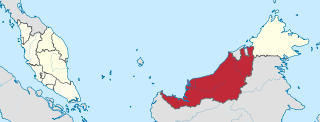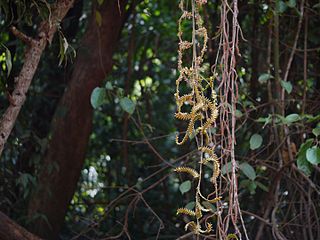
Punan Ba or Punan is an ethnic group found in Sarawak, Malaysia and in Kalimantan, Indonesia. The Punan Bah people are distinct and unrelated to the semi-nomadic Penan people. Their name stems from two rivers along the banks of which they have been living since time immemorial. They do have other names: Mikuang Bungulan or Mikuang and Aveang Buan. But those terms are only used ritually these days.

Betong Division, formed on 26 March 2002, is one of the twelve administrative divisions in Sarawak, Malaysia. Formerly part of Sri Aman Division, Betong is in the Saribas area. It has a total area of 4,180.8 square kilometres, and is the smallest of the administrative divisions of Sarawak.

Betong is a town and of the Betong Division in Sarawak, Malaysia, lying in the Saribas area. It used to be placed under the district of Sri Aman.

Mukah Division is one of the twelve administrative divisions in Sarawak, Malaysia. It was established on 1 March 2002 and it has a total area of 6,997.61 square kilometres.

Kuching Division is one of the twelve administrative divisions in Sarawak, Malaysia. Formerly part of what was called the "First Division", it is the center and the starting point of modern Sarawak. Kuching Division has a total area of 4,559.5 square kilometres.

Melanau or A-Likou are an ethnic group indigenous to Sarawak, Malaysia. They are among the earliest settlers of Sarawak. They speak in the Melanau language, which is part of North Bornean branch of Malayo-Polynesian languages. In 2010, there are estimated to be 123,410 who consider themselves Melanau, making it the fifth largest ethnic group in Sarawak. Even though a minority in Sarawak, Melanau forms a large part of Sarawak's political sphere, 5 out of 6 of Yang di-Pertua Negeri of Sarawak is of Melanau ethnicity including the current Yang di-Pertua Tun Pehin Sri Abdul Taib Mahmud and 2 out of 5 of Chief Ministers of Sarawak are ethnic Melanau.

Limbang Division is one of the twelve administrative divisions of Sarawak, Malaysia. It has a total area of 7,788.50 square kilometres, and is the fourth largest division after Kapit Division, Miri Division and Bintulu Division. Limbang Division consists of two districts which are Limbang and Lawas, together with a single sub-district under Limbang and two sub-districts under Lawas. Long Semadoh and Ba’kelalan are rural settlements in the southern part of Lawas district. Two major towns in Limbang are Limbang and Lawas. There are also few smaller towns such as Sundar, Trusan, Merapok and Tedungan.

The Bintulu District is one of two districts of Bintulu Division in Sarawak, Malaysia. It has a total area of 7,220.40 square kilometres. Bintulu District has a sub-district, which is Sebauh. There are two towns in Bintulu District, namely Bintulu and Sebauh.

The Limbang District is one of the two districts of Limbang Division, Malaysia. It has a total area of 3,976.00 square kilometres. The major town is Limbang. It has one sub-district, which is Nanga Medamit. It borders Brunei Darussalam to the west and east, Lawas District to the southeast and Miri District at the south and southwest. Due to being squeezed in between Brunei at its north and coastal areas, Limbang is accessible by road only by going through immigration posts. According to history, this area was annexed by Charles Anthoni Johnson Brooke, the second Rajah of Sarawak in 1890 from Brunei to become the fifth division of Sarawak. The annexation was strongly disputed by Brunei.

Balingian is a town in Sarawak, Malaysia. It lies approximately 286.1 kilometres (178 mi) east-north-east of the state capital Kuching.

Selangau, Sarawak, is a small town which is located by the Pan Borneo Highway(Sibu-Bintulu Road). It is also located by Batang Mukah, a river which flows to the South China Sea. It is located approximately 74 km from Sibu town, 84 km from Mukah town and 134 km from Bintulu town. Selangau town is the administrative centre for the Selangau District.
Sarawak's population is very diverse, comprising many races and ethnic groups. Sarawak has more than 40 sub-ethnic groups, each with its own distinct language, culture and lifestyle. This makes Sarawak demography very distinct and unique compared to its Peninsular counterpart.

Data Kakus is a remote Kenyah Badeng village settlement in the hilly interior of the Ulu Kakus Tatau division of Sarawak, Malaysia elevates to 650 metres, not far from Tubau and Belaga district. To be exact, Data Kakus is located at the upstream of Sungai Burok and Sungai Nyabet. The highest peak in Ulu Kakus is called Gunung Lumut about 828m located on the peak of Lumut Range not too far from Sungai Bekuyat and Sungai Kakus.

Mukah is a coastal town which serves as the administrative center of the Mukah District in Mukah Division, Sarawak, Malaysia. It is located by the South China Sea, about 2 hours by road from the city of Sibu. Mukah is also accessible by air by MASwings from Kuching and Miri. The duration of both flights is about one hour. There are also speed boats connecting the town of Dalat to Sibu. The speed boat trip takes approximately 2 hours.
Kampung Senap is a remote Kenyah Badeng village settlement in the hilly interior of the Ulu Sg. Tinggang, Tubau, Sebauh, Bintulu division of Sarawak, Malaysia, elevates to 620 metres, not far from Tubau and Sebauh Sub-district. Kampung Senep is located at the upstream of Sungai Tinggang and Sungai Senep. The highest peak in Ulu Senep is called Gunung Lumut about 828 m located on the peak of Lumut Range not too far from Sungai Bekuyat and Sungai Kakus.
Bintulu is a federal constituency in Sarawak, Malaysia, that has been represented in the Dewan Rakyat since 1971.


























